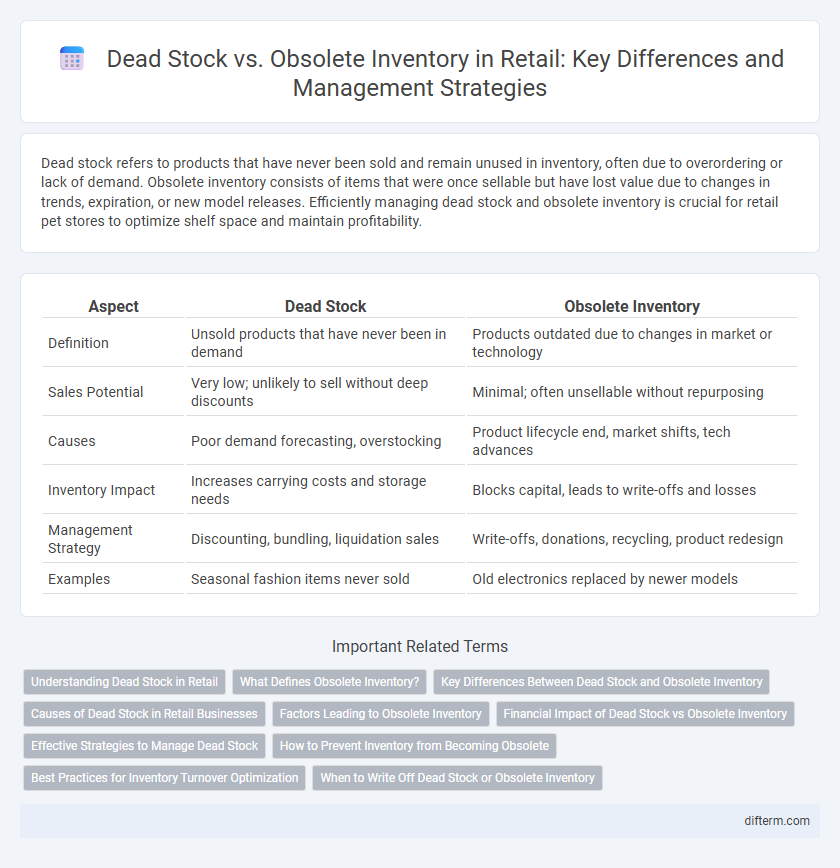Dead stock refers to products that have never been sold and remain unused in inventory, often due to overordering or lack of demand. Obsolete inventory consists of items that were once sellable but have lost value due to changes in trends, expiration, or new model releases. Efficiently managing dead stock and obsolete inventory is crucial for retail pet stores to optimize shelf space and maintain profitability.
Table of Comparison
| Aspect | Dead Stock | Obsolete Inventory |
|---|---|---|
| Definition | Unsold products that have never been in demand | Products outdated due to changes in market or technology |
| Sales Potential | Very low; unlikely to sell without deep discounts | Minimal; often unsellable without repurposing |
| Causes | Poor demand forecasting, overstocking | Product lifecycle end, market shifts, tech advances |
| Inventory Impact | Increases carrying costs and storage needs | Blocks capital, leads to write-offs and losses |
| Management Strategy | Discounting, bundling, liquidation sales | Write-offs, donations, recycling, product redesign |
| Examples | Seasonal fashion items never sold | Old electronics replaced by newer models |
Understanding Dead Stock in Retail
Dead stock in retail refers to inventory items that remain unsold and have not moved for an extended period, tying up capital and storage space. This inventory often results from over-purchasing, inaccurate demand forecasting, or changes in consumer preferences, leading to reduced profitability and potential markdowns. Proper identification and management of dead stock are crucial to minimizing financial losses and optimizing inventory turnover.
What Defines Obsolete Inventory?
Obsolete inventory refers to products that have lost their value and demand due to factors such as changes in consumer preferences, technological advancements, or market trends. Unlike dead stock, which may still be sellable but remains unsold for extended periods, obsolete inventory is unlikely to be sold without significant discounting or disposal. Retailers identifying obsolete inventory must assess product lifecycle stages and market relevance to optimize inventory management and reduce carrying costs.
Key Differences Between Dead Stock and Obsolete Inventory
Dead stock refers to unsold retail items that remain in inventory due to lack of demand or poor sales forecasting, whereas obsolete inventory includes products that have lost value because of aging, expiration, or market changes. Dead stock typically consists of current or seasonal products that failed to sell, while obsolete inventory often involves outdated models or expired goods that retailers can no longer sell at full value. Effective inventory management hinges on distinguishing dead stock from obsolete inventory to implement appropriate clearance strategies and prevent financial losses.
Causes of Dead Stock in Retail Businesses
Dead stock in retail primarily arises from inaccurate demand forecasting, leading to excess inventory that fails to sell within its intended timeframe. Changes in consumer preferences, seasonal fluctuations, and product lifecycle mismanagement further contribute to unsold merchandise accumulating in warehouses. Ineffective inventory control systems and poor supplier coordination exacerbate dead stock issues, increasing holding costs and reducing overall profitability.
Factors Leading to Obsolete Inventory
Obsolete inventory in retail arises primarily from shifts in consumer demand, technological advancements, and inaccurate demand forecasting. Factors such as seasonality, product lifecycle changes, and poor inventory management also contribute to stock becoming outdated. Unlike dead stock, which may still be salable, obsolete inventory typically loses value due to its inability to meet current market trends.
Financial Impact of Dead Stock vs Obsolete Inventory
Dead stock ties up capital without generating revenue, leading to increased holding costs and reduced cash flow, which impacts a retailer's financial health. Obsolete inventory often requires markdowns or write-offs, directly diminishing profit margins and inflating waste management expenses. Both dead stock and obsolete inventory strain operational efficiency, but obsolete inventory typically results in more immediate financial losses due to its diminished resale value.
Effective Strategies to Manage Dead Stock
Dead stock consists of unsold inventory that remains sellable but stagnant over time, while obsolete inventory refers to products no longer marketable due to changes in demand or expiration. Effective strategies to manage dead stock include implementing dynamic pricing models, leveraging data analytics for demand forecasting, and optimizing inventory turnover through targeted promotions or bundle offers. Retailers can also enhance supply chain visibility to preempt excess inventory accumulation and employ automated systems to identify slow-moving items promptly.
How to Prevent Inventory from Becoming Obsolete
Implement regular inventory audits and demand forecasting using data analytics to identify slow-moving products that risk becoming obsolete. Employ just-in-time (JIT) inventory management to reduce excess stock and adjust purchase orders based on real-time sales trends. Collaborate with suppliers for flexible return policies and implement dynamic pricing strategies to liquidate potential dead stock before it turns obsolete.
Best Practices for Inventory Turnover Optimization
Effective inventory turnover optimization in retail involves distinguishing dead stock from obsolete inventory to implement targeted clearance strategies and accurate demand forecasting. Employing real-time inventory tracking systems and data analytics enhances the identification of slow-moving items, enabling timely markdowns, promotions, or liquidation to minimize holding costs. Regular inventory audits combined with supplier collaboration facilitate stock level adjustments that reduce excess inventory, improving cash flow and shelf space efficiency.
When to Write Off Dead Stock or Obsolete Inventory
Dead stock should be written off when it remains unsold beyond its shelf life despite promotions or price reductions, tying up valuable capital and storage space. Obsolete inventory, often caused by product discontinuation or market changes, requires write-off decisions based on its inability to generate future sales or fit evolving consumer demand. Timely identification and financial adjustment of these inventory types help maintain accurate asset valuation and optimize cash flow in retail operations.
Dead Stock vs Obsolete Inventory Infographic

 difterm.com
difterm.com